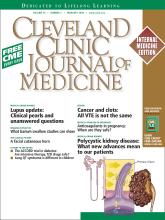Table of Contents
From the Editor
- The battle of the clot
In this issue we review two situations in which low-molecular-weight heparins have special advantages: in pregnant women and in patients with cancer.
The Clinical Picture
- A facial cutaneous horn
A healthy 84-year-old woman has an asymptomatic lesion on her cheek that has grown progressively over the past 10 months. What is it?
Medical Grand Rounds
- Autosomal dominant polycystic kidney disease: Emerging concepts of pathogenesis and new treatments
Some of the mystery of autosomal dominant polycystic kidney disease is starting to clear. As a result, some promising new treatments are in clinical trials.
Imaging in Practice
- Role of barium esophagography in evaluating dysphagia
A 55-year-old woman presents with an intermittent sensation of food getting stuck in her mid to lower chest. How should her symptoms best be evaluated?
Medical Problems in Pregnancy
- Anticoagulants and pregnancy: When are they safe?
Thrombotic risk is higher in pregnancy, and some women need anticoagulant therapy. Unfractionated heparin and low-molecular-weight heparins are effective and safe, with caveats.
Review
- Cancer and clots: All cases of venous thromboembolism are not treated the same
Idiopathic venous thromboembolism can be the first sign of cancer, although how extensively one should search for cancer in these cases is not clear.
Medical Grand Rounds
- Lupus update: Perspective and clinical pearls
Patients with systemic lupus erythematosus have a markedly better survival rate today, but they face a greater risk of cancer, cardiovascular disease, and osteoporosis at early ages.




